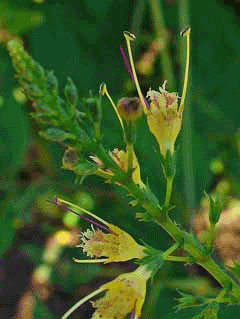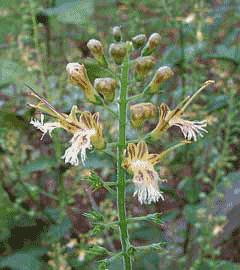 |
|
|
 |
| http://commons.wikimedia.org/wiki/User:Phyzome |
Translate this page:
Summary
Physical Characteristics

 Collinsonia canadensis is a PERENNIAL growing to 0.8 m (2ft 7in) by 0.4 m (1ft 4in).
Collinsonia canadensis is a PERENNIAL growing to 0.8 m (2ft 7in) by 0.4 m (1ft 4in).
See above for USDA hardiness. It is hardy to UK zone 4. It is in flower in August. The species is hermaphrodite (has both male and female organs) and is pollinated by Insects.
Suitable for: light (sandy) and medium (loamy) soils. Suitable pH: mildly acid, neutral and basic (mildly alkaline) soils. It can grow in semi-shade (light woodland). It prefers moist or wet soil.
UK Hardiness Map
US Hardiness Map
Synonyms
Collinsonia cuneata. Collinsonia decussata. Collinsonia ovalis. Pleuradenia praecox.
Plant Habitats
Woodland Garden Dappled Shade; Shady Edge; Bog Garden;
Edible Uses
References More on Edible Uses
Medicinal Uses
Plants For A Future can not take any responsibility for any adverse effects from the use of plants. Always seek advice from a professional before using a plant medicinally.
Alterative Antispasmodic Diaphoretic Diuretic Sedative Tonic Urinary Vasodilator
Vulnerary
The whole plant, but especially the fresh root, is alterative, antispasmodic, diaphoretic, diuretic, sedative, tonic, vasodilator and vulnerary[4, 21, 46, 102, 165]. A tea made from the roots is strongly diuretic, it is valuable in the treatment of all complaints of the urinary system and the rectum and is used in the treatment of piles, indigestion, diarrhoea, kidney complaints etc[4, 222]. It has proved of benefit in the treatment of irritable bowel syndrome, mucous colitis and varicose veins[254]. The root is seldom used on its own but is contained in remedies with other herbs, especially Aphanes arvensis, Eupatorium purpureum and Hydrangea arborescens[238]. The roots contain more than 13,000 parts per million of rosmarinic acid, the same anti-oxidant that is found in rosemary[222]. The fresh leaves are strongly emetic[222]. Some caution is advised, see notes above on toxicity[222]. A poultice of the leaves or roots is applied to burns, bruises, sores, sprains etc[4, 222, 254].
References More on Medicinal Uses
The Bookshop: Edible Plant Books
Our Latest books on Perennial Plants For Food Forests and Permaculture Gardens in paperback or digital formats.

Edible Tropical Plants
Food Forest Plants for Hotter Conditions: 250+ Plants For Tropical Food Forests & Permaculture Gardens.
More

Edible Temperate Plants
Plants for Your Food Forest: 500 Plants for Temperate Food Forests & Permaculture Gardens.
More

More Books
PFAF have eight books available in paperback and digital formats. Browse the shop for more information.
Shop Now
Other Uses
References More on Other Uses
Cultivation details
Prefers a sandy peat in a moist situation but it is easily grown in ordinary garden soils[1] so long as they are not dry[200]. Prefers dappled shade[200]. The whole plant has a strong disagreeable odour and a pungent spicy taste[4]. Another report says that the foliage is strongly aromatic, with a lemon scent[238].
References Carbon Farming Information and Carbon Sequestration Information
Temperature Converter
Type a value in the Celsius field to convert the value to Fahrenheit:
Fahrenheit:
The PFAF Bookshop
Plants For A Future have a number of books available in paperback and digital form. Book titles include Edible Plants, Edible Perennials, Edible Trees,Edible Shrubs, Woodland Gardening, and Temperate Food Forest Plants. Our new book is Food Forest Plants For Hotter Conditions (Tropical and Sub-Tropical).
Shop Now
Plant Propagation
Seed - best sown as soon as it is ripe in a cold frame. The seed can also be sown in the spring, though it might be slower to germinate. Prick out the seedlings into individual pots when they are large enough to handle and grow them on in light shade in a greenhouse or cold frame. Plant them out in spring or early summer of their second year. Division in spring[1].
Other Names
If available other names are mentioned here
Native Range
NORTHERN AMERICA: Canada (Québec, Ontario (south)), United States (Indiana, Massachusetts, Michigan, New Hampshire, New Jersey, New York, Ohio, Pennsylvania, Rhode Island, Vermont, West Virginia, Missouri (southeast), Illinois, Wisconsin, Alabama, Delaware, Florida (north), Georgia, Kentucky, Louisiana, Maryland, Mississippi, North Carolina, South Carolina, Tennessee, Virginia, Texas)
Weed Potential
Right plant wrong place. We are currently updating this section.
Please note that a plant may be invasive in one area but may not in your area so it's worth checking.
Conservation Status
IUCN Red List of Threatened Plants Status :

Growth: S = slow M = medium F = fast. Soil: L = light (sandy) M = medium H = heavy (clay). pH: A = acid N = neutral B = basic (alkaline). Shade: F = full shade S = semi-shade N = no shade. Moisture: D = dry M = Moist We = wet Wa = water.
Now available:
Food Forest Plants for Mediterranean Conditions
350+ Perennial Plants For Mediterranean and Drier Food Forests and Permaculture Gardens.
[Paperback and eBook]
This is the third in Plants For A Future's series of plant guides for food forests tailored to
specific climate zones. Following volumes on temperate and tropical ecosystems, this book focuses
on species suited to Mediterranean conditions—regions with hot, dry summers and cool, wet winters,
often facing the added challenge of climate change.
Read More
Expert comment
Author
L.
Botanical References
43200
Links / References
For a list of references used on this page please go here
Readers comment